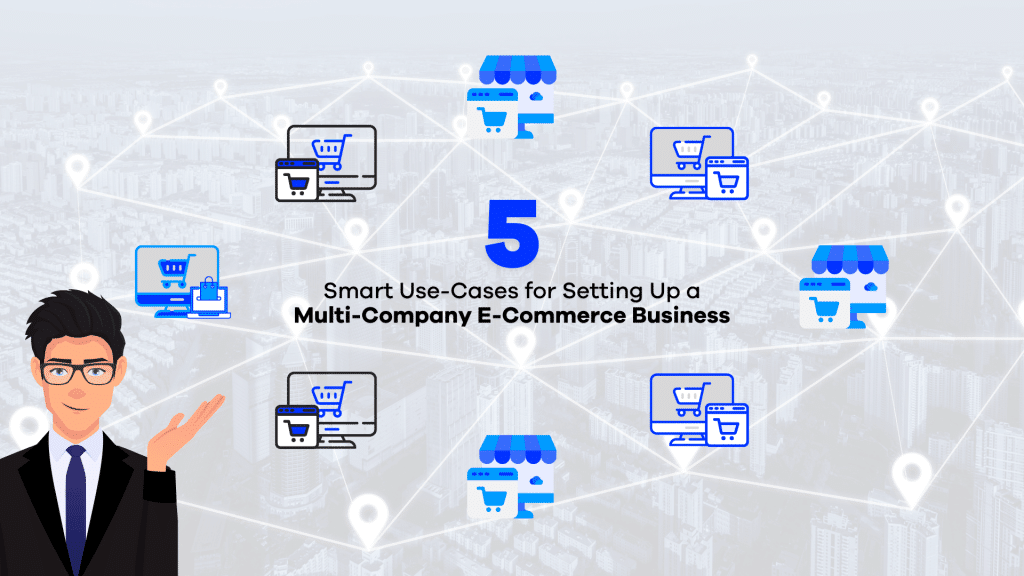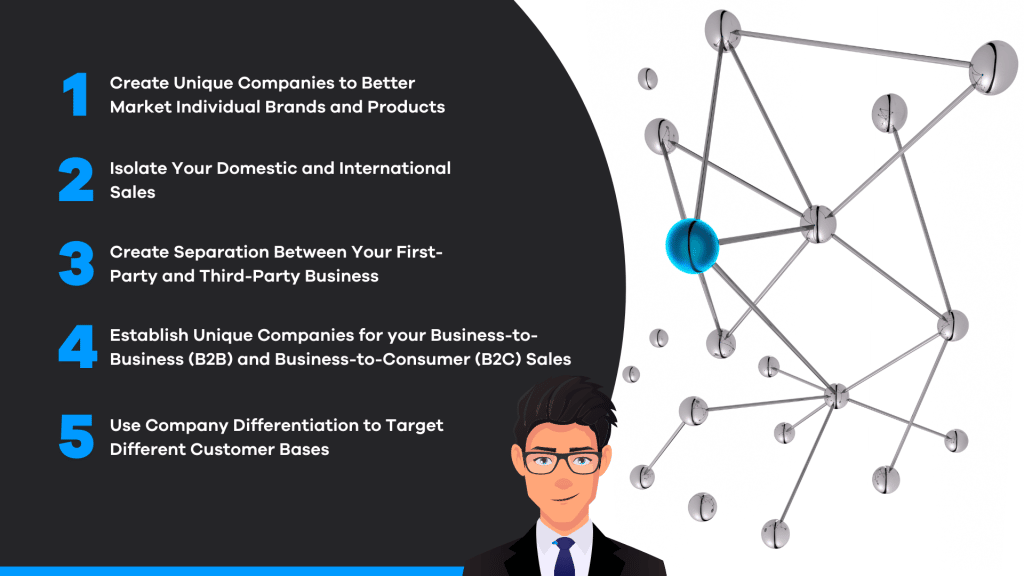
Selling across multiple channels is a must in today’s ecommerce environment. In some cases, this omnichannel approach can (and should) be extended to a multi-company ecommerce business.
A multi-company ecommerce plan works if there is a parent company that controls several child companies. Each child company can have its own names, brands, logos, webstores, marketplace accounts, SKUs, listing defaults, and accounting.
At the same time, companies operating under the same parent company can share vital resources such as inventory, warehouse space, product catalogs, address books, and staffing. This multi-company approach results in an organizational structure that can scale and manage a complex omnichannel ecommerce business while offering many benefits associated with smaller, niche brands.
Furthermore, the ability of multi-company businesses to share a consolidated set of resources, tools, locations, and labor across their brands means an increased potential for efficiency and profitability compared to singular, boutique-style online retailers.
At Descartes Sellercloud, we recognize the value of multi-company ecommerce, but we also recognize the organizational challenges that come with it. That’s why our omnichannel growth platform features company settings that make it easy for your business to create new companies, manage existing ones, and reap the benefits of this consolidated approach to differentiation.
Several high-value use cases make multi-company ecommerce especially alluring. If any of the following align with your current business practices or growth priorities, operating multiple companies may be particularly viable.
1. Create Unique Companies to Better Market Individual Brands and Products
It isn’t uncommon for omnichannel ecommerce businesses to find success selling different SKUs that are only tangentially related, if at all. While finding success with a single yet diverse catalog is possible, trying to unite a wide assortment of products under a single retail umbrella can pose challenges for branding and marketing efforts.
Spinning off related product lines into their own companies can allow you to create unique branding, websites, marketplace accounts, and marketing materials that can make it easier to build a loyal customer base and more efficiently cross-sell and upsell to increase order sizes.
Moreover, Descartes Sellercloud lets you manage all of these elements within the same unified platform as if you were still operating as a singular company.
2. Isolate Your Domestic and International Sales
International ecommerce has become an increasingly profitable opportunity for ecommerce sellers to expand their reach globally. However, there are some challenges and differences between domestic and international retail that need attention.
For one, there are unique fulfillment and accounting considerations associated with selling abroad. You will likely have unique marketplaces, vendors, and channels for international sales. Splitting your ecommerce business into dedicated companies for your domestic and international customers makes this easier to manage.
Separate bookkeeping, marketplace accounts, websites, shopping carts, and third-party partners can help make your focus on international markets easier and more focused. For example, if you sell on both Amazon US and Amazon UK, you must have different marketplace and API credentials for each to upload products and download orders.
Descartes Sellercloud’s multiple company features allow users to control an Amazon US account from one company and an Amazon UK account from another within a single, unified interface.

3. Create a Separation Between Your First-Party and Third-Party Business
There is tremendous value in transforming your third-party retail business into first-party sales. That said, many businesses continue to profit from their established third-party sales channels even after expanding into direct-to-consumer (D2C), dropshipping, and/or wholesale ecommerce.
Creating and managing your first-party sales under a dedicated company, separate from your existing third-party retail channels, can provide several benefits. One of the most significant is the ability to market and brand your first-party company without worrying about complying with some restrictive compliance measures imposed by third-party marketplaces.
This separation makes it possible to employ strategic moves to promote and grow first-party sales like direct-to-consumer marketing, collecting and compiling certain customer analytics, and unfettered repricing strategies.
If your first- and third-party business is all conducted as a single company, many of these practices could result in marketplace suspensions or account bans that could strike a costly blow to your third-party retail success.
4. Establish Unique Companies for your Business-to-Business (B2B) and Business-to-Consumer (B2C) Sales
One of the biggest mistakes you can make when expanding your B2C ecommerce brand into B2B sales is simply mimicking your B2C strategies as if the two types of ecommerce are the same. In addition to the differences between customer bases, B2B and B2C ecommerce operate fundamentally differently regarding listings, orders, marketing, branding, and accounting.
These functional differences can cause headaches for omnichannel brands trying to operate as both B2B and B2C entities simultaneously. A multi-company strategy to divide your business into B2B and B2C components can help avoid potential pitfalls.
5. Use Company Differentiation to Target Different Customer Bases
Whether any of the aforementioned situations apply to your ecommerce business, there are still many additional benefits to operating a multi-company ecommerce brand. One is the ability to create companies that target specific customer bases. Certain products have broad appeal across multiple niches that may not be conducive to monolithic branding or marketing approaches.
By establishing multiple independent brands that cater to your various primary and secondary audiences, you can create listings, packaging, promotions, and templates that target particular customer avatars without alienating others.
For example, if you sell a hair brush that is effective for both women and long-haired dog breeds, it would likely be bad for the business to try to appeal to both applications in the same listing. Establishing separate brands allows you to create one set of omnichannel listings and marketing efforts tailored to your human clientele and another for dog owners.
In each of these situations, a multi-company ecommerce strategy gives your business an increased degree of flexibility and efficiency that can help scale your business and expand your reach.
Descartes Sellercloud’s omnichannel growth platform makes the process simple. With our software and tools, you can operate a multi-company business with the same efficiency and convenience as a single company.
Contact us directly for a free demo and see for yourself.




